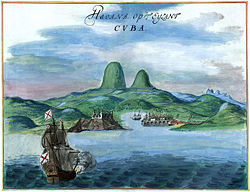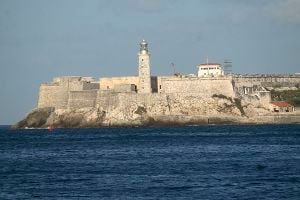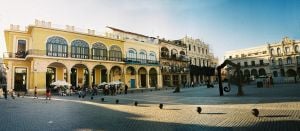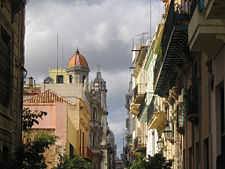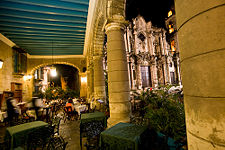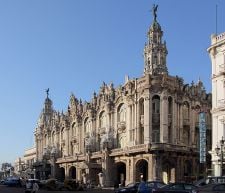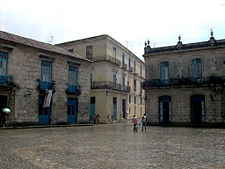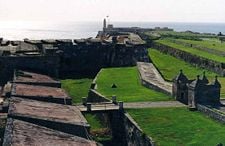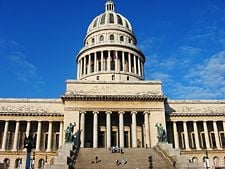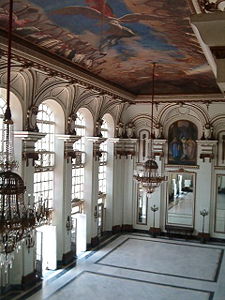Difference between revisions of "Old Havana" - New World Encyclopedia
Mary Anglin (talk | contribs) m |
Rosie Tanabe (talk | contribs) |
||
| (31 intermediate revisions by 5 users not shown) | |||
| Line 1: | Line 1: | ||
| − | {{Images OK}} | + | {{Images OK}}{{Submitted}}{{Approved}}{{Copyedited}} |
{{Infobox World Heritage Site | {{Infobox World Heritage Site | ||
| WHS = Old Havana and its Fortifications | | WHS = Old Havana and its Fortifications | ||
| Line 13: | Line 13: | ||
}} | }} | ||
| − | '''Old Havana''' ({{lang-es|La Habana Vieja}}) | + | '''Old Havana''' ({{lang-es|La Habana Vieja}}) describes the central area of the original city of [[Havana]], [[Cuba]]. Havana is a city of great [[architecture|architectural]] character, containing many treasures from the city's long and colorful history. Old Havana and its fortifications were designated a [[UNESCO]] [[World Heritage Site]] in 1982. |
| − | + | Following a royal Spanish decree by [[Philip II of Spain]] in 1561, all ships headed for [[Spain]] from the [[New World]] were required to assemble their fleets in [[Havana Bay]] in order to counteract [[pirate]] attacks on [[galleon]] convoys. This decree boosted commerce and development of the adjacent city of Havana. In 1563, the Spanish Governor of the island moved from [[Santiago de Cuba]] to Havana, marking the point when the city became Cuba's ''de facto'' capital. On December 20, 1592, King Philip II granted Havana the title of [[city]]. Later, the city would be officially designated as "Key to the New World and Rampart of the West Indies" by the Spanish crown. At the middle of the eighteenth century, Havana had more than 70,000 inhabitants. It was then the third largest city in [[the Americas]], ranking behind [[Lima]], [[Peru]] and [[Mexico City]] but ahead of [[Boston]] and [[New York City]]. | |
| − | + | {{toc}} | |
| − | + | The colonial settlement of Havana thus played a significant role in the shaping of the [[Caribbean Sea]] region as well as much of [[South America]]. Old Havana's buildings are historical treasures and are architecturally important as well. Spanish colonial structures, [[Baroque]] churches, and buildings in [[Neoclassic]] style fill its narrow streets and alleyways. Although many of these historic treasures fell into ruin in the latter half of the twentieth century following the [[Cuban Revolution]], many are restored. As part of the World Heritage Site program, they will be preserved and this legacy will be passed on to future generations. | |
| − | |||
==History== | ==History== | ||
| + | [[Image:Havana 1639b.jpg|right|thumb|250px|Havana Bay, c. 1639.]] | ||
| + | [[File:FaroCastillodelMoro-Cuba-ene2017.jpg|thumb|[[Castillo de los Tres Reyes Magos del Morro|El Morro Castle]]]] | ||
| + | [[Image:Square in Old Havana.jpg|thumb|Square in Old Havana]] | ||
[[Spain]] established the city of [[Havana]] on the island of [[Cuba]] in 1519, one of the first cities in the [[western hemisphere]] to be founded by [[Europe]]ans. The history of Havana spans three basic periods: the Spanish colonial period from 1519 to 1898; the American neocolonial period from 1898 to 1959; and the revolutionary period which began in 1960. The urban landscape clearly reflects elements of each of these periods. | [[Spain]] established the city of [[Havana]] on the island of [[Cuba]] in 1519, one of the first cities in the [[western hemisphere]] to be founded by [[Europe]]ans. The history of Havana spans three basic periods: the Spanish colonial period from 1519 to 1898; the American neocolonial period from 1898 to 1959; and the revolutionary period which began in 1960. The urban landscape clearly reflects elements of each of these periods. | ||
It was the during the nearly 400-year colonial period that the core of the city was built in the Spanish colonial style. Its distinguished [[architecture]] led to it being designated a [[UNESCO]] [[World Heritage Site]] in 1982. | It was the during the nearly 400-year colonial period that the core of the city was built in the Spanish colonial style. Its distinguished [[architecture]] led to it being designated a [[UNESCO]] [[World Heritage Site]] in 1982. | ||
| − | + | Havana's first settlement was built on the western edge of [[Havana Bay]]. Regular attacks by [[buccaneer]]s, [[piracy|pirates]], and French [[corsair]]s prompted the Spaniards to begin fortifying the city. Four imposing colonial forts constructed of [[coral]]-[[limestone]] flank Havana Bay. Two of these are at the entrance to the channel, on the north the Castillo del Morro (now a maritime museum) and on the south the Castillo de la Punta (now the Museum of Fortifications and Armaments). On the north side of the channel is the massive Fortaleza de San Carlos de la Cabana (now containing a [[museum]] of [[ceramic]] arts). On the channel's south side is the Castillo de la Real Fuerza. | |
| − | |||
| − | Havana's first settlement was built on the western edge of [[Havana Bay]]. Regular attacks by [[buccaneer]]s, [[piracy|pirates]], and French [[corsair]]s prompted the Spaniards to begin fortifying the city. Four imposing colonial forts constructed of [[coral]]-[[limestone]] flank Havana Bay. Two of these are at the entrance to the channel, on the north the Castillo del Morro (now a maritime museum) and on the south the Castillo de la Punta (now the Museum of Fortifications and Armaments). On the north side of the channel is the massive Fortaleza de San Carlos de la Cabana (now containing a museum of ceramic arts). On the channel's south side is the Castillo de la Real Fuerza | ||
| − | |||
| − | |||
| − | + | In 1523, King [[Charles I of Spain]] mandated the ''Procedures for the creation of cities in the New World.'' These procedures indicated that after outlining a city's plan, growth should follow a grid centered on the square shape of the plaza. Havana's original central plaza is known as the ''Plaza de Armas.'' Surrounding this plaza were important military, political, and religious buildings. Castillo de la Real Fuerza was built adjacent to the plaza on its north side. | |
| − | + | Other early constructions around the plaza included the Palacio de los Capitanes Generales, the Palacio de Segundo Cabo, the Plaza del Catedral, and the Plaza de Armas. Dominating the plaza is the [[cathedral]], known as either the ''Catedral de la Habana'' or the ''Catedral de la Concepción Inmaculada.'' | |
| − | Spain | + | To counteract pirate attacks on [[galleon]] convoys headed for [[Spain]], following a royal decree in 1561 all ships headed for Spain were required to assemble their fleets in the Havana Bay. Ships arrived from May through August, waiting for the best weather conditions, and together, the fleet departed Havana for Spain by September. By the seventeenth century the city had become one of the main [[ship-building]] centers in the New World. |
| − | + | Spain found it necessary to protect many of its colonial coastal cities from attacks by both [[pirate]]s and foreign powers. From 1674 to 1797 walls were built around the city of Havana, enclosing an area of approximately three square kilometers (about 1 sq mi). In 1863 these walls were torn down to accommodate the growing city, which eventually expanded to about nine sq km (three sq mi). | |
| + | While modern Havana has expanded beyond its original settlement, the narrow streets of Old Havana contain many buildings; monuments, forts, convents and churches, palaces, and alleyways that hold the history of its colonial days. Many structures fell into ruin in the latter half of the twentieth century, but a number are being restored. | ||
| + | ==Main Sights== | ||
| + | [[Image:Old Havana architecture.jpg|225px|right|thumb|Old Havana overview]] | ||
| + | [[Image:TommyImages_com-Plaza_Catedral_Havana_Cuba.jpg|225px|thumb|Plaza de la Catedral, the heart of Old Havana]] | ||
| + | [[File:Havana Cathedral and Square (Jan 2014).jpg|225px|right|thumb|[[Havana cathedral|San Cristóbal Cathedral]], named for [[Christopher Columbus]].]] | ||
| + | [[File:Grand Theater of Havana 01.jpg|225px|right|thumb|[[Great Theater of Havana]]]] | ||
| + | [[Image:Plaza de la Catedral (Havana) 2.jpg|225px|right|thumb|Plaza de la Catedral a La Habana]] | ||
| + | [[Image:Fortaleza de San Carlos de la Cabaña, Havana.jpg|thumb|right|225px|La Cabaña]] | ||
| + | [[Image:CapitolioNacionalHavana.jpg|thumb|225px|Main steps leading up to the portico of the National Capitol Building]] | ||
| + | [[Image:Hvnapalacebllrm.jpg|thumb|225px|The ballroom in the former Cuban Presidential Palace, today the Museum of the Revolution in Old Havana]] | ||
| + | *[[Plaza de Armas]] is the plaza around which the city was built. Cities constructed by the Spanish [[Conquistador]]es in the New World were designed in a standard military fashion based on a [[grid pattern]] surrounding a central plaza. The Plaza de Armas is surrounded by governmental buildings, churches, and other structures of cultural or political significance. The name derives from the fact that this area would be a refuge in case of an attack upon the city, from which arms would be supplied to the defenders. | ||
| − | + | *[[Plaza Vieja]] was built in 1584. While it contains numerous landmarks, it differs from other plazas in that public and religious buildings are absent. Surrounding it were the homes of the city's colonial elite. Many of these homes fell into serious disrepair and are in various stages of restoration. The [[Casa de los Condes de Jaruco]] in this plaza has been fully restored and stands as an excellent example of a late colonial mansion. | |
| − | [[ | ||
| − | [[ | ||
| − | |||
| + | *[[Morro Castle (fortress)|Castillo del Morro]] is a picturesque fortress guarding the entrance to Havana Bay built in 1589. Perched on the promontory on the opposite side of the harbor from Old Havana it can be viewed from miles around as it dominates the port entrance. Built initially in response to raids on Havana harbor, el Morro protected the mouth of the harbor with a chain being strung out across the water to the fort at La Punta. It first saw action in the 1762 [[British expedition against Cuba]] when [[George Keppel, 3rd Earl of Albemarle|Lord Albemarle]] landed in Cojimar and attacked the fort defended by [[Luis Vicente de Velasco e Isla]] from its rear. It fell because the British could command the high ground. When the island was returned to [[Spain|Spanish]] rule in 1763, the [[La Cabaña|fort at La Cabaña]] was built to prevent this happening again. | ||
| − | + | *[[La Cabaña]] is an eighteenth century [[fortress]] complex located on the elevated eastern side of Havana's harbor entrance and is the city's the most impressive fortress. Construction of La Cabaña was begun in 1763 by Spain's King [[Charles III of Spain|Carlos III]] following the temporary capture of Havana by [[British Empire|British]] forces. Replacing earlier fortifications next to the sixteenth century [[Morro Castle (fortress)|El Morro]] fortress, La Cabaña was the largest colonial military installation in the [[New World]] by the time it was completed in 1774, at great expenses to Spain. The fortress served as both a military base and [[prison]] over the next two hundred years for both [[Spain]] and an independent [[Cuba]]. La Cabaña was used as a military prison during the [[Fulgencio Batista|Batista]] regime. In January 1959, rebels led by [[Che Guevara]] captured La Cabaña and used it as a headquarters for several months while leading the [[Cuban revolution]]. The complex is now part of a historical park, along with El Morro, and houses several [[museum]]s open to the public. | |
| + | *[[San Salvador de la Punta Fortress]] is opposite the Castle of El Morro. Construction was begun in 1590. In 1595 a [[hurricane]] severely damaged the fortress. By 1602 reconstruction had not been completed, and it was decided to turn the structure into a keep, holding some 10 to 12 artillery pieces. In 1762 its safety curtains and bastions were destroyed during the British invasion. When the Spanish resumed control of the island La Punta saw repair, and in the nineteenth century four esplanades built to accommodate a corresponding number of artillery pieces, were added at La Punta. | ||
| − | + | *[[Castillo de la Real Fuerza]] is set back from the harbor's entrance, and borders the [[Plaza de Armas, Havana|Plaza de Armas]]. The fortress is considered to be the oldest [[stone]] fortress in [[the Americas.]] A previous fortress, the Fuerza Vieja (Old Force), was badly damaged in 1555 during an attack on Havana by the French privateer [[Jacques de Sores]] and eventually was demolished in 1582. In 1558 [[Bartolomé Sánchez]], an engineer appointed by [[Phillip II of Spain]], began work on the new fortress, initially known as the ''Fuerza Nueva'' (New Force). The Fuerza Vieja was set back from the harbor, but the new fortress was planned to be closer to the harbor to give it a better strategic position. The ironworks were established in 1558, but the first stones were not laid until 1562. Construction was delayed due to complaints from local residents forced to relocate to make way for the building and from disagreements between Sánchez and the Governor of Havana. The fortress was not completed until 1577, with slaves and French prisoners providing most of the labor. Built of [[limestone]] quarried from the Havana shoreline, the fortification incorporated thick sloping walls, a moat and drawbridge. Despite being positioned closer to the harbor than the Fuerza Vieja, it quickly became apparent that the new fortress was still too distant from the mouth of the harbor to serve effectively as a defensive bulwark, so was instead adopted by [[Juan de Tejeda]] as the residence of the Governor of Havana. | |
| − | *[[ | ||
| − | |||
| − | |||
| − | |||
| − | |||
| − | |||
| − | |||
| − | |||
| − | |||
| − | |||
| − | |||
| + | *[[Havana cathedral|Catedral de San Cristóbal]] is the most prominent building on the Plaza de la Catedral. Built in 1748 by order of the bishop from [[Salamanca]], [[Jose Felipe de Trespalacios]], it is said to be the only example of a baroque construction that possesses asymmetrical features - one of the towers is wider than the other. This particular feature was conceived in order to allow the water that tended to accumulate on the plaza to freely flow through the streets. | ||
| + | *[[National Capitol Building (Havana)|El Capitolio]], or the ''National Capitol Building,'' was the seat of government in [[Cuba]] until after the [[Cuban Revolution]] in 1959, and is now home to the [[Cuban Academy of Sciences]]. Its design and name recall the [[U.S. Capitol]] in [[Washington, D.C.]], but it is only superficially similar. Completed in 1929, it was the tallest building in [[Havana]] until the 1950s and houses ''La Estatua de la República,'' the world's third largest indoor [[statue]]. | ||
| − | + | *[[Galician Center]], of ''neobarroque'' style, was built between 1907 and 1914 as a social club for [[Galician people|Galician]] emigrants. Built on the Theater Tacon (now known as Great Theater of Havana), it was inaugurated during the [[Carnival]] of 1838 with five masked dances. | |
| − | + | *Gran Teatro de la Habana, the [[Great Theater of Havana]] was officially opened in 1838, although its first presentation occurred in November 1837. It is located in Paseo del Prado, in a building known as the ''Palacio del Centro Gallego.'' The original building was demolished in 1914 to open the way to the one that currently exists, an exponent in the German [[neo-baroque]] [[architecture]] style. The theater is adorned with a [[stone]] and [[marble]] statue. There are also sculptural pieces by [[Giuseppe Moretti]], representing allegories depicting benevolence, education, music and theater. The current building construction began in 1908, was opened in 1915 with an opera season offered by important lyrical figures of the time. It was not until 1985, and as initiative of the prima ballerina [[Alicia Alonso]] that the building was renamed and became the Great Theatre of Havana. Today it is the permanent headquarters of the [[National Ballet of Cuba]] and the main stage for the [[International Ballet Festival of Havana]]. It has rooms of theaters, concert, conferences and video, as well as, galleries of visual arts, a choral center, several halls test for ''danzarias'' groupings and dancing arts. | |
| − | |||
| − | |||
| − | |||
| + | *[[San Francisco de la Habana Basilica]] contains the basilica and the monastery of [[Francis of Assisi]], built from 1580-1591, the original home of Havana's [[Franciscan Order|Franciscan]] community. Originally a statue of [[Saint Francis]] stood atop the 138-foot bell tower, but it was destroyed by a [[cyclone]] in 1846. The [[cloister]] of the adjacent [[monastery]] dates back to 1739 and now houses a [[museum]] of holy art. In front of the Basilica stands a [[bronze]] life-size statue by [[Jose Villa Soberon]] of [[Jose Maria Lopez Lledin]] known as ''El Caballero de Paris'' (1899-1985) who is buried inside the Basilica. The building, no longer a church, is now used for concerts. | ||
| − | + | *The [[Museum of the Revolution]] is located in Old Havana's former [[Presidential Palace]]. The structure was designed by the Cuban architect [[Carlos Maruri]] and the Belgian architect [[Paul Belau]] and was inaugurated in 1920 by President [[Mario García Menocal]]. It remained the Presidential Palace until 1959. It was converted into the Museum of the Revolution during the years following the [[Cuban Revolution]]. The museum's exhibits are largely devoted to the period of the revolutionary war of the 1950s and to the country's post-1959 history. Portions of the museum are also devoted to pre-revolutionary Cuba, including its [[Cuban War of Independence|War of Independence]] waged against [[Spain]]. Behind the building lies the Granma Memorial, a large glass enclosure which houses the ''[[Granma (yacht)|Granma]],'' the yacht which took [[Fidel Castro]] and his revolutionaries from [[Mexico]] to Cuba for the revolution. There are also various vehicles and tanks used in the revolution displayed. | |
| − | |||
| − | |||
| − | |||
==References== | ==References== | ||
| − | *Harvey, David Alan. 1999. "The Rebirth of Old Havana - Renovation in the heart of Cuba's capital city illuminates centuries of architectural splendor" | + | *Harvey, David Alan. 1999. "The Rebirth of Old Havana - Renovation in the heart of Cuba's capital city illuminates centuries of architectural splendor." ''National Geographic'' 195 (6): 36. |
*Lobo Montalvo, María Luisa, Zoila Lapique Becali, and Alicia García Santana. 2000. ''Havana: history and architecture of a romantic city.'' [New York, N.Y.]: Monacelli Press. ISBN 9781580930529 | *Lobo Montalvo, María Luisa, Zoila Lapique Becali, and Alicia García Santana. 2000. ''Havana: history and architecture of a romantic city.'' [New York, N.Y.]: Monacelli Press. ISBN 9781580930529 | ||
| − | *Sapieha, Nicolas, and Francesco Venturi. 1990. ''Old Havana, Cuba'' | + | *Sapieha, Nicolas, and Francesco Venturi. 1990. ''Old Havana, Cuba.'' (Travel to landmarks.) London: Tauris Parke Books. ISBN 9781850432210 |
*''UNESCO World Heritage Centre''. [http://whc.unesco.org/en/list/204 Old Havana and its Fortifications] Retrieved December 2, 2008. | *''UNESCO World Heritage Centre''. [http://whc.unesco.org/en/list/204 Old Havana and its Fortifications] Retrieved December 2, 2008. | ||
| − | |||
| − | |||
| − | |||
| − | |||
[[Category:Geography]] | [[Category:Geography]] | ||
| Line 95: | Line 85: | ||
[[Category:World Heritage Sites]] | [[Category:World Heritage Sites]] | ||
| − | {{ | + | {{credits|Old_Havana|250676518|Morro_Castle_(fortress)|252737514|La_Cabaña|239804333|Castillo_de_la_Real_Fuerza|251782016|El_Capitolio|239706828|Great_Theatre_of_Havana|243288790|Museum_of_the_Revolution|252988537}} |
Latest revision as of 00:04, 18 November 2022
| Old Havana and its Fortifications* | |
|---|---|
| UNESCO World Heritage Site | |
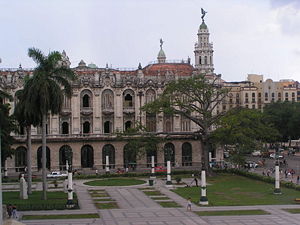
| |
| State Party | |
| Type | Cultural |
| Criteria | iv, v |
| Reference | 204 |
| Region** | Latin America and the Caribbean |
| Inscription history | |
| Inscription | 1982 (6th Session) |
| * Name as inscribed on World Heritage List. ** Region as classified by UNESCO. | |
Old Havana (Spanish: La Habana Vieja) describes the central area of the original city of Havana, Cuba. Havana is a city of great architectural character, containing many treasures from the city's long and colorful history. Old Havana and its fortifications were designated a UNESCO World Heritage Site in 1982.
Following a royal Spanish decree by Philip II of Spain in 1561, all ships headed for Spain from the New World were required to assemble their fleets in Havana Bay in order to counteract pirate attacks on galleon convoys. This decree boosted commerce and development of the adjacent city of Havana. In 1563, the Spanish Governor of the island moved from Santiago de Cuba to Havana, marking the point when the city became Cuba's de facto capital. On December 20, 1592, King Philip II granted Havana the title of city. Later, the city would be officially designated as "Key to the New World and Rampart of the West Indies" by the Spanish crown. At the middle of the eighteenth century, Havana had more than 70,000 inhabitants. It was then the third largest city in the Americas, ranking behind Lima, Peru and Mexico City but ahead of Boston and New York City.
The colonial settlement of Havana thus played a significant role in the shaping of the Caribbean Sea region as well as much of South America. Old Havana's buildings are historical treasures and are architecturally important as well. Spanish colonial structures, Baroque churches, and buildings in Neoclassic style fill its narrow streets and alleyways. Although many of these historic treasures fell into ruin in the latter half of the twentieth century following the Cuban Revolution, many are restored. As part of the World Heritage Site program, they will be preserved and this legacy will be passed on to future generations.
History
Spain established the city of Havana on the island of Cuba in 1519, one of the first cities in the western hemisphere to be founded by Europeans. The history of Havana spans three basic periods: the Spanish colonial period from 1519 to 1898; the American neocolonial period from 1898 to 1959; and the revolutionary period which began in 1960. The urban landscape clearly reflects elements of each of these periods.
It was the during the nearly 400-year colonial period that the core of the city was built in the Spanish colonial style. Its distinguished architecture led to it being designated a UNESCO World Heritage Site in 1982.
Havana's first settlement was built on the western edge of Havana Bay. Regular attacks by buccaneers, pirates, and French corsairs prompted the Spaniards to begin fortifying the city. Four imposing colonial forts constructed of coral-limestone flank Havana Bay. Two of these are at the entrance to the channel, on the north the Castillo del Morro (now a maritime museum) and on the south the Castillo de la Punta (now the Museum of Fortifications and Armaments). On the north side of the channel is the massive Fortaleza de San Carlos de la Cabana (now containing a museum of ceramic arts). On the channel's south side is the Castillo de la Real Fuerza.
In 1523, King Charles I of Spain mandated the Procedures for the creation of cities in the New World. These procedures indicated that after outlining a city's plan, growth should follow a grid centered on the square shape of the plaza. Havana's original central plaza is known as the Plaza de Armas. Surrounding this plaza were important military, political, and religious buildings. Castillo de la Real Fuerza was built adjacent to the plaza on its north side.
Other early constructions around the plaza included the Palacio de los Capitanes Generales, the Palacio de Segundo Cabo, the Plaza del Catedral, and the Plaza de Armas. Dominating the plaza is the cathedral, known as either the Catedral de la Habana or the Catedral de la Concepción Inmaculada.
To counteract pirate attacks on galleon convoys headed for Spain, following a royal decree in 1561 all ships headed for Spain were required to assemble their fleets in the Havana Bay. Ships arrived from May through August, waiting for the best weather conditions, and together, the fleet departed Havana for Spain by September. By the seventeenth century the city had become one of the main ship-building centers in the New World.
Spain found it necessary to protect many of its colonial coastal cities from attacks by both pirates and foreign powers. From 1674 to 1797 walls were built around the city of Havana, enclosing an area of approximately three square kilometers (about 1 sq mi). In 1863 these walls were torn down to accommodate the growing city, which eventually expanded to about nine sq km (three sq mi).
While modern Havana has expanded beyond its original settlement, the narrow streets of Old Havana contain many buildings; monuments, forts, convents and churches, palaces, and alleyways that hold the history of its colonial days. Many structures fell into ruin in the latter half of the twentieth century, but a number are being restored.
Main Sights
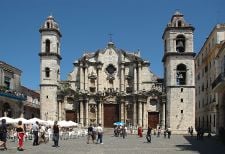
- Plaza de Armas is the plaza around which the city was built. Cities constructed by the Spanish Conquistadores in the New World were designed in a standard military fashion based on a grid pattern surrounding a central plaza. The Plaza de Armas is surrounded by governmental buildings, churches, and other structures of cultural or political significance. The name derives from the fact that this area would be a refuge in case of an attack upon the city, from which arms would be supplied to the defenders.
- Plaza Vieja was built in 1584. While it contains numerous landmarks, it differs from other plazas in that public and religious buildings are absent. Surrounding it were the homes of the city's colonial elite. Many of these homes fell into serious disrepair and are in various stages of restoration. The Casa de los Condes de Jaruco in this plaza has been fully restored and stands as an excellent example of a late colonial mansion.
- Castillo del Morro is a picturesque fortress guarding the entrance to Havana Bay built in 1589. Perched on the promontory on the opposite side of the harbor from Old Havana it can be viewed from miles around as it dominates the port entrance. Built initially in response to raids on Havana harbor, el Morro protected the mouth of the harbor with a chain being strung out across the water to the fort at La Punta. It first saw action in the 1762 British expedition against Cuba when Lord Albemarle landed in Cojimar and attacked the fort defended by Luis Vicente de Velasco e Isla from its rear. It fell because the British could command the high ground. When the island was returned to Spanish rule in 1763, the fort at La Cabaña was built to prevent this happening again.
- La Cabaña is an eighteenth century fortress complex located on the elevated eastern side of Havana's harbor entrance and is the city's the most impressive fortress. Construction of La Cabaña was begun in 1763 by Spain's King Carlos III following the temporary capture of Havana by British forces. Replacing earlier fortifications next to the sixteenth century El Morro fortress, La Cabaña was the largest colonial military installation in the New World by the time it was completed in 1774, at great expenses to Spain. The fortress served as both a military base and prison over the next two hundred years for both Spain and an independent Cuba. La Cabaña was used as a military prison during the Batista regime. In January 1959, rebels led by Che Guevara captured La Cabaña and used it as a headquarters for several months while leading the Cuban revolution. The complex is now part of a historical park, along with El Morro, and houses several museums open to the public.
- San Salvador de la Punta Fortress is opposite the Castle of El Morro. Construction was begun in 1590. In 1595 a hurricane severely damaged the fortress. By 1602 reconstruction had not been completed, and it was decided to turn the structure into a keep, holding some 10 to 12 artillery pieces. In 1762 its safety curtains and bastions were destroyed during the British invasion. When the Spanish resumed control of the island La Punta saw repair, and in the nineteenth century four esplanades built to accommodate a corresponding number of artillery pieces, were added at La Punta.
- Castillo de la Real Fuerza is set back from the harbor's entrance, and borders the Plaza de Armas. The fortress is considered to be the oldest stone fortress in the Americas. A previous fortress, the Fuerza Vieja (Old Force), was badly damaged in 1555 during an attack on Havana by the French privateer Jacques de Sores and eventually was demolished in 1582. In 1558 Bartolomé Sánchez, an engineer appointed by Phillip II of Spain, began work on the new fortress, initially known as the Fuerza Nueva (New Force). The Fuerza Vieja was set back from the harbor, but the new fortress was planned to be closer to the harbor to give it a better strategic position. The ironworks were established in 1558, but the first stones were not laid until 1562. Construction was delayed due to complaints from local residents forced to relocate to make way for the building and from disagreements between Sánchez and the Governor of Havana. The fortress was not completed until 1577, with slaves and French prisoners providing most of the labor. Built of limestone quarried from the Havana shoreline, the fortification incorporated thick sloping walls, a moat and drawbridge. Despite being positioned closer to the harbor than the Fuerza Vieja, it quickly became apparent that the new fortress was still too distant from the mouth of the harbor to serve effectively as a defensive bulwark, so was instead adopted by Juan de Tejeda as the residence of the Governor of Havana.
- Catedral de San Cristóbal is the most prominent building on the Plaza de la Catedral. Built in 1748 by order of the bishop from Salamanca, Jose Felipe de Trespalacios, it is said to be the only example of a baroque construction that possesses asymmetrical features - one of the towers is wider than the other. This particular feature was conceived in order to allow the water that tended to accumulate on the plaza to freely flow through the streets.
- El Capitolio, or the National Capitol Building, was the seat of government in Cuba until after the Cuban Revolution in 1959, and is now home to the Cuban Academy of Sciences. Its design and name recall the U.S. Capitol in Washington, D.C., but it is only superficially similar. Completed in 1929, it was the tallest building in Havana until the 1950s and houses La Estatua de la República, the world's third largest indoor statue.
- Galician Center, of neobarroque style, was built between 1907 and 1914 as a social club for Galician emigrants. Built on the Theater Tacon (now known as Great Theater of Havana), it was inaugurated during the Carnival of 1838 with five masked dances.
- Gran Teatro de la Habana, the Great Theater of Havana was officially opened in 1838, although its first presentation occurred in November 1837. It is located in Paseo del Prado, in a building known as the Palacio del Centro Gallego. The original building was demolished in 1914 to open the way to the one that currently exists, an exponent in the German neo-baroque architecture style. The theater is adorned with a stone and marble statue. There are also sculptural pieces by Giuseppe Moretti, representing allegories depicting benevolence, education, music and theater. The current building construction began in 1908, was opened in 1915 with an opera season offered by important lyrical figures of the time. It was not until 1985, and as initiative of the prima ballerina Alicia Alonso that the building was renamed and became the Great Theatre of Havana. Today it is the permanent headquarters of the National Ballet of Cuba and the main stage for the International Ballet Festival of Havana. It has rooms of theaters, concert, conferences and video, as well as, galleries of visual arts, a choral center, several halls test for danzarias groupings and dancing arts.
- San Francisco de la Habana Basilica contains the basilica and the monastery of Francis of Assisi, built from 1580-1591, the original home of Havana's Franciscan community. Originally a statue of Saint Francis stood atop the 138-foot bell tower, but it was destroyed by a cyclone in 1846. The cloister of the adjacent monastery dates back to 1739 and now houses a museum of holy art. In front of the Basilica stands a bronze life-size statue by Jose Villa Soberon of Jose Maria Lopez Lledin known as El Caballero de Paris (1899-1985) who is buried inside the Basilica. The building, no longer a church, is now used for concerts.
- The Museum of the Revolution is located in Old Havana's former Presidential Palace. The structure was designed by the Cuban architect Carlos Maruri and the Belgian architect Paul Belau and was inaugurated in 1920 by President Mario García Menocal. It remained the Presidential Palace until 1959. It was converted into the Museum of the Revolution during the years following the Cuban Revolution. The museum's exhibits are largely devoted to the period of the revolutionary war of the 1950s and to the country's post-1959 history. Portions of the museum are also devoted to pre-revolutionary Cuba, including its War of Independence waged against Spain. Behind the building lies the Granma Memorial, a large glass enclosure which houses the Granma, the yacht which took Fidel Castro and his revolutionaries from Mexico to Cuba for the revolution. There are also various vehicles and tanks used in the revolution displayed.
ReferencesISBN links support NWE through referral fees
- Harvey, David Alan. 1999. "The Rebirth of Old Havana - Renovation in the heart of Cuba's capital city illuminates centuries of architectural splendor." National Geographic 195 (6): 36.
- Lobo Montalvo, María Luisa, Zoila Lapique Becali, and Alicia García Santana. 2000. Havana: history and architecture of a romantic city. [New York, N.Y.]: Monacelli Press. ISBN 9781580930529
- Sapieha, Nicolas, and Francesco Venturi. 1990. Old Havana, Cuba. (Travel to landmarks.) London: Tauris Parke Books. ISBN 9781850432210
- UNESCO World Heritage Centre. Old Havana and its Fortifications Retrieved December 2, 2008.
Credits
New World Encyclopedia writers and editors rewrote and completed the Wikipedia article in accordance with New World Encyclopedia standards. This article abides by terms of the Creative Commons CC-by-sa 3.0 License (CC-by-sa), which may be used and disseminated with proper attribution. Credit is due under the terms of this license that can reference both the New World Encyclopedia contributors and the selfless volunteer contributors of the Wikimedia Foundation. To cite this article click here for a list of acceptable citing formats.The history of earlier contributions by wikipedians is accessible to researchers here:
- Old_Havana history
- Morro_Castle_(fortress) history
- La_Cabaña history
- Castillo_de_la_Real_Fuerza history
- El_Capitolio history
- Great_Theatre_of_Havana history
- Museum_of_the_Revolution history
The history of this article since it was imported to New World Encyclopedia:
Note: Some restrictions may apply to use of individual images which are separately licensed.
